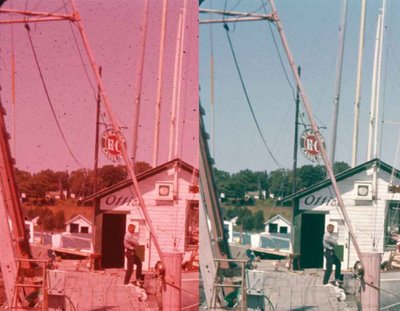Nikon CoolScan V slide scanner
Those dusty old photographic slides that have faded to red might not be lost. Below is a sample of what the Nikon CoolScan V dedicated slide scanner (~C$550) can do, in conjunction with VueScan, a scanner driver package (U$40). On the left is a corner of an original image with no processing -- just as it appears when viewed by eye. Notice the horrible red colour cast, and click on the image to see all the dust specks. On the right is the image after being scanned and processed.

(Click the image to see it in detail, especially dust specks.)
This is about 1/8 of a slide. Ektachrome, about 50 yrs old.
The colour correction is dramatic but actually not all that hard to fix, in principle -- the slide's colour dyes have faded at differing rates and the correction software just shifts them back into proportion. The dust cleaning is much trickier -- the scanner has a fourth scanning channel, infra-red, which passed through film but not through junk (eg., dust) on the film That infra-red channel information tells the software what areas of the picture need to be 'patched' (filled in from surrounding pixels).
It’s totally hopeless to scan slides on a scanner without an infra-red channel -- the dust is a killer. I spent HOURS per slide fixing up scans from an old flatbed scanner (without an infra-red channel) prior to getting this slide scanner about a year ago. Now I don't even bother trying to blow off the dust with compressed air, etc.
Even with all these miracle technologies, slide scanning is still tedious and mind-numbing. Each slide takes about a minute -- too long to wait, too short to do other things. It can be done somewhat in the background, but it's still disruptive -- I do a lot of reading of news and writing of email while scanning.
Ektachrome seems most vulnerable to the variable-rate fading. Some Kodachrome are terrible, others are great (some of my father's Kodachrome from the 1940's are just about gone, others are like new). I wonder if the variation is due to processing issues (my guess), the film, storage, or the exposure? Or maybe it is due to projection -- I've heard that a slide loses 50% of its colour after 4 minutes of projection, due to the intense light.
Once digitized, the photos won't fade or get dirty.
This is about 1/8 of a slide. Ektachrome, about 50 yrs old.
The colour correction is dramatic but actually not all that hard to fix, in principle -- the slide's colour dyes have faded at differing rates and the correction software just shifts them back into proportion. The dust cleaning is much trickier -- the scanner has a fourth scanning channel, infra-red, which passed through film but not through junk (eg., dust) on the film That infra-red channel information tells the software what areas of the picture need to be 'patched' (filled in from surrounding pixels).
It’s totally hopeless to scan slides on a scanner without an infra-red channel -- the dust is a killer. I spent HOURS per slide fixing up scans from an old flatbed scanner (without an infra-red channel) prior to getting this slide scanner about a year ago. Now I don't even bother trying to blow off the dust with compressed air, etc.
Even with all these miracle technologies, slide scanning is still tedious and mind-numbing. Each slide takes about a minute -- too long to wait, too short to do other things. It can be done somewhat in the background, but it's still disruptive -- I do a lot of reading of news and writing of email while scanning.
Ektachrome seems most vulnerable to the variable-rate fading. Some Kodachrome are terrible, others are great (some of my father's Kodachrome from the 1940's are just about gone, others are like new). I wonder if the variation is due to processing issues (my guess), the film, storage, or the exposure? Or maybe it is due to projection -- I've heard that a slide loses 50% of its colour after 4 minutes of projection, due to the intense light.
Once digitized, the photos won't fade or get dirty.